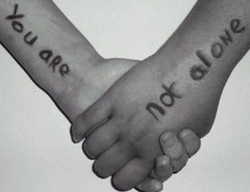Why is depression in Young Adult Literature So Important?
Lets start with some statistics...
Teendepression.org
|
Families for Depression Awareness
|
Depression Can Affect Anyone...
Depression is not determined by age, race, gender, heritage, or any other identifier. It is a serious mental illness that can be linked to trauma, family mental health history, stress, poor self esteem, bullying, other mental illnesses, and many more factors. Due to this, depression can affect everyone. Depression can lead to other mental illnesses and suicide. The National Mental Health Association stated that each year approximately 2 million U.S. adolescents attempt suicide.
The Role of Literature

Due to the fact that depression affects such a large part of modern day youth, it has obviously become a relevant topic with today's teens. Although young adult literature that portrays characters suffering from depression, or includes suicide, may be thought of as inappropriate; it is a fact that today's youth are at high risk for depression. The topic of depression or suicide found in the books on this site is most likely culturally relevant to many teens. If 2/10 teens will experience depression before they reach adulthood I think it is quite obvious just how culturally relevant and relatable these texts are to today's youth. Having literature available for them to which they can relate could help young adults to form their own identity and to be more understanding and accepting of those around them. If a reader believes that they are depressed or that they have a friend that is, relatable novels could be a source of great comfort and support to them. Not only that, but stories that the reader can relate to have the ability to inspire them and alter their views of the world. Literature can be an extremely powerful tool. As Sherman Alexie states in an article titled "Why the Best Kids' Books are Written in Blood",
"And now I write books for teenagers because I vividly remember what it felt like to be a teen facing everyday and epic dangers. I don’t write to protect them. It’s far too late for that. I write to give them weapons–in the form of words and ideas-that will help them fight their monsters. I write in blood because I remember what it felt like to bleed."
Alexie's statement is extremely powerful. Literature has the ability to save lives. This is also why the content of the novels and the messages they send are just as important as their topics. Due to this, I will be assessing the books I review partially using the Images & Encounters Profile by Blaska and Lynch. This profile asks the reader to attempt to locate 10 criteria in the novel they are reading as they pertain to characters with disabilities or illnesses. These ten criteria are listed below.
The ten criteria are:
"And now I write books for teenagers because I vividly remember what it felt like to be a teen facing everyday and epic dangers. I don’t write to protect them. It’s far too late for that. I write to give them weapons–in the form of words and ideas-that will help them fight their monsters. I write in blood because I remember what it felt like to bleed."
Alexie's statement is extremely powerful. Literature has the ability to save lives. This is also why the content of the novels and the messages they send are just as important as their topics. Due to this, I will be assessing the books I review partially using the Images & Encounters Profile by Blaska and Lynch. This profile asks the reader to attempt to locate 10 criteria in the novel they are reading as they pertain to characters with disabilities or illnesses. These ten criteria are listed below.
The ten criteria are:
- Promotes empathy not pity.
- Depicts acceptance not ridicule.
- Emphasizes success rather than, or in addition, to failure.
- Promotes positive images of persons with disabilities or illness.
- Assists children in gaining accurate understanding of the disability or illness.
- Demonstrates respect for persons with disabilities or illness.
- Promotes attitude of "one of us" not "one of them."
- Uses language which stresses person first, disability second philosophy, i.e. Jody who is blind.
- Describes the disability or person with disabilities or illness as realistic (i.e., not subhuman or superhuman.)
- Illustrates characters in a realistic manner.
